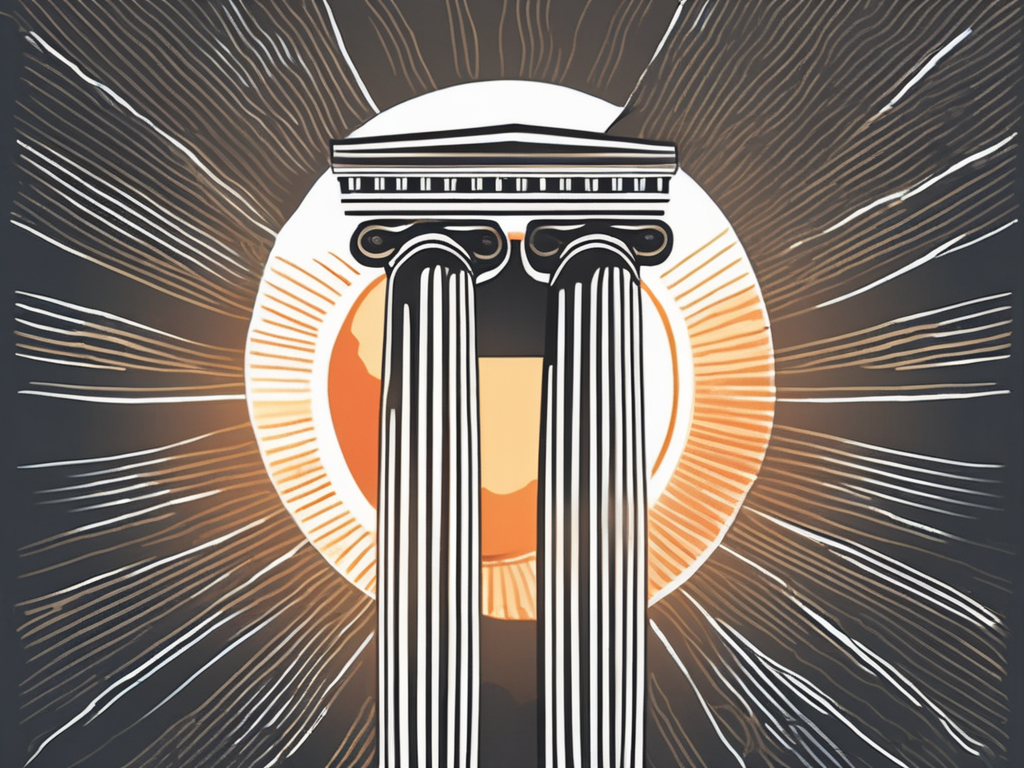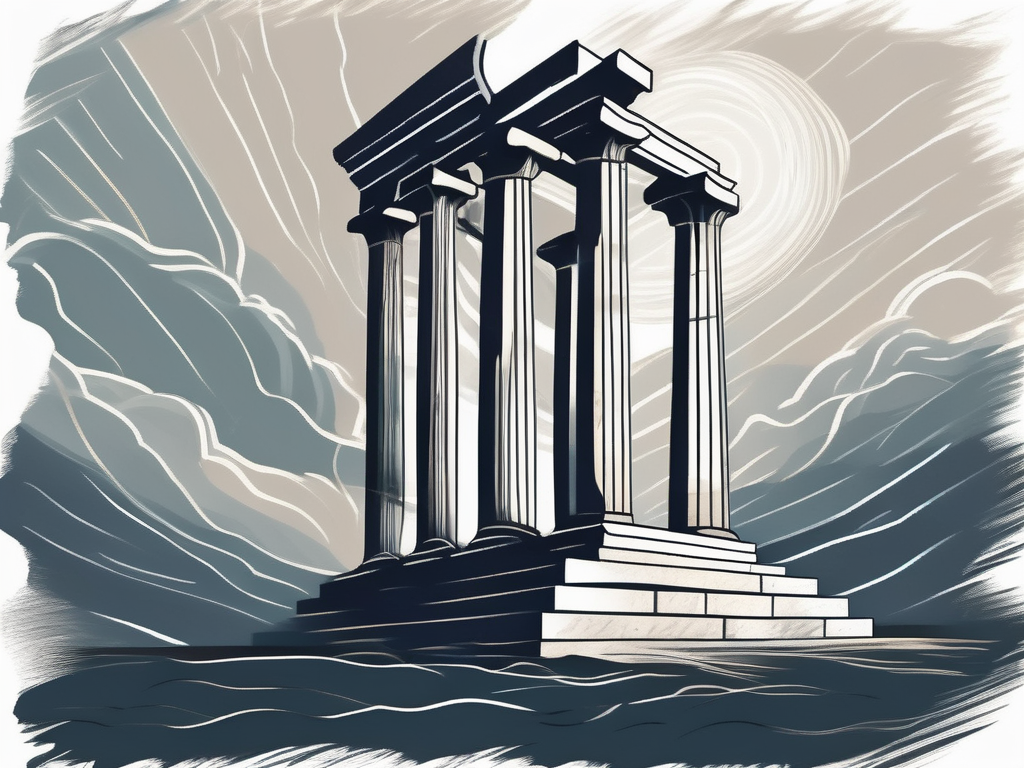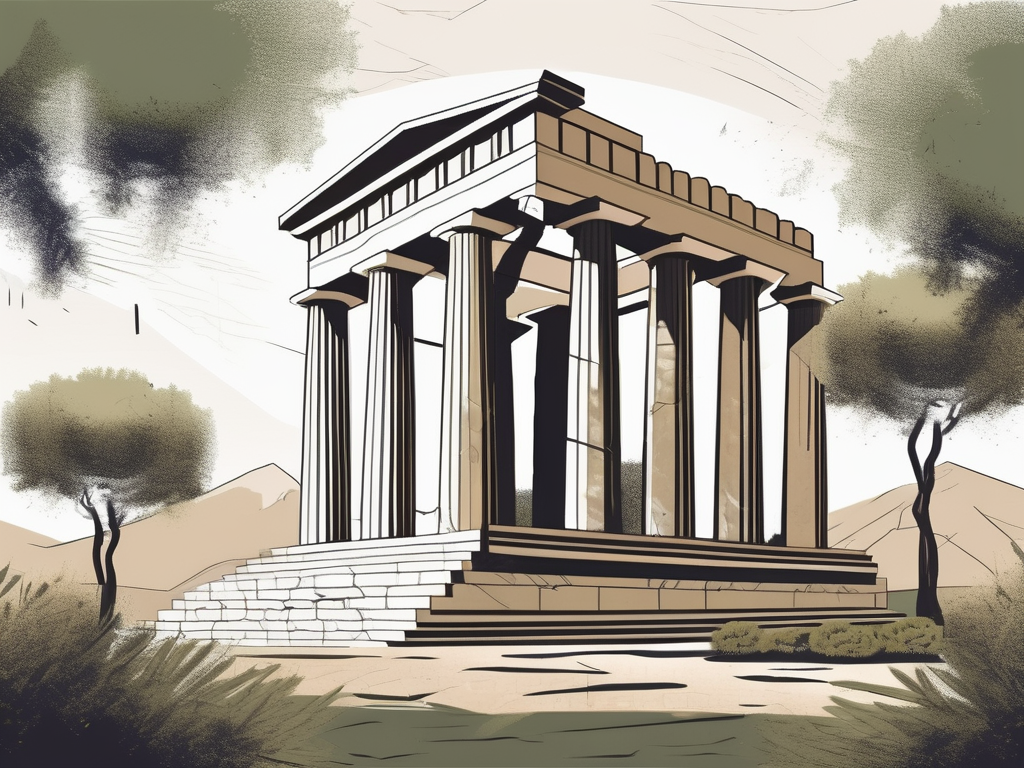Stoicism, with its emphasis on self-discipline, inner peace, and the acceptance of fate, has become increasingly popular in recent years. But where did this ancient philosophy come from? To truly understand Stoicism and its relevance in modern times, it is essential to delve into its ancient roots.
Understanding Stoicism: A Brief Overview
Stoicism originated in ancient Greece around the 3rd century BCE, flourishing during the Hellenistic period. Its name is derived from the Stoa Poikile, a painted colonnade in Athens where the Stoics would gather for philosophical discussions. The philosophy was then further developed during the Roman Empire.
During its early days, Stoicism attracted a diverse range of individuals, from merchants and politicians to slaves and emperors. The Stoics believed that everyone, regardless of their social status, had the capacity to live a virtuous life and achieve inner tranquility.
The Stoics emphasized the importance of reason and rationality in navigating the challenges of life. They believed that by cultivating a strong sense of self-discipline and practicing self-control, individuals could overcome their desires and passions, leading to a more fulfilling and meaningful existence.
The Core Principles of Stoicism
At the heart of Stoicism lie several key principles. One of the central tenets is the idea that we cannot control external events, but we can control our reactions to them. Stoics believed in living in accordance with nature and accepting the inevitable ups and downs of life with equanimity. They advocated for the practice of virtue, maintaining inner tranquility, and the pursuit of wisdom.
Stoicism also placed great emphasis on the concept of “amor fati,” which translates to “love of fate.” This principle encourages individuals to embrace their circumstances, whether favorable or unfavorable, and view them as opportunities for growth and self-improvement. By accepting and embracing the present moment, Stoics believed that one could find peace and contentment.
Furthermore, Stoicism emphasized the importance of living a life of moral virtue. The Stoics believed that true happiness and fulfillment could only be achieved through virtuous actions and the cultivation of good character. They saw virtue as the ultimate goal of human life, and everything else, such as wealth, fame, and external success, as secondary and ultimately insignificant.
The Influence of Stoicism on Modern Philosophy
Stoicism has had a profound impact on modern philosophy, particularly in the fields of ethics and psychology. Many philosophers and thinkers, such as Friedrich Nietzsche and Michel Foucault, have drawn inspiration from Stoic teachings. They have explored the Stoic concepts of self-mastery, resilience, and the pursuit of inner peace in their own works.
Additionally, the rise of cognitive-behavioral therapy owes a debt to the Stoic emphasis on rational thinking and the control of one’s emotions. Cognitive-behavioral therapists often draw on Stoic principles to help individuals develop healthier thought patterns and cope with life’s challenges more effectively.
Stoicism’s enduring legacy can also be seen in various aspects of modern society. Its teachings on self-discipline, resilience, and the acceptance of things beyond our control continue to resonate with individuals seeking personal growth and fulfillment. Stoicism serves as a timeless reminder of the power of our own thoughts and actions in shaping our lives.
Tracing the Beginnings of Stoicism
To understand the origins of Stoicism, it is crucial to explore the lives and ideas of the philosophy’s founding fathers and the historical context in which they lived.
The Founding Fathers of Stoicism
The three most prominent figures in the development of Stoicism were Zeno of Citium, Cleanthes, and Chrysippus. Zeno, the founder of the school, laid the groundwork for Stoic philosophy with his teachings on ethics and physics. He believed that virtue is the highest good and that we should live in accordance with nature. Zeno’s ideas resonated with many, and his school attracted a significant following.
Cleanthes, Zeno’s successor, expanded upon these ideas and emphasized the importance of living in accordance with nature. He believed that by aligning ourselves with the natural order of the universe, we can achieve tranquility and inner peace. Cleanthes was known for his disciplined lifestyle and his commitment to practicing what he preached.
Chrysippus, the third leader of the school, is credited with systematizing Stoic logic. He developed a comprehensive system of reasoning and argumentation, which became an integral part of Stoic philosophy. Chrysippus’ logical framework provided Stoics with a powerful tool for understanding the world and making sound judgments.
The Hellenistic Period: The Birthplace of Stoicism
The Hellenistic period, characterized by the conquests of Alexander the Great and the subsequent blending of Greek, Persian, and Egyptian cultures, provided the fertile ground for the emergence of Stoicism. During this time, the Greek city of Athens became a vibrant center of intellectual discourse, attracting scholars and philosophers from all over the Mediterranean.
It is in Athens that Stoicism took root and flourished. The city’s intellectual climate, with its diverse mix of cultures and ideas, provided the perfect environment for the development and spread of new philosophical schools. Stoicism, with its emphasis on personal ethics and the pursuit of wisdom, found a receptive audience among the educated elite of Athens.
Stoicism also benefited from the wider cultural and intellectual exchange that took place during the Hellenistic period. The conquests of Alexander the Great brought Greek culture into contact with the rich traditions of Persia and Egypt. This cross-pollination of ideas and beliefs contributed to the development of a more cosmopolitan worldview, which Stoicism embraced.
Furthermore, the Hellenistic period was marked by political and social upheaval. The collapse of the Greek city-states and the rise of powerful empires created a sense of uncertainty and instability. In this context, Stoicism offered a philosophy of personal resilience and inner strength. It provided individuals with a framework for navigating the challenges of a rapidly changing world.
Overall, the beginnings of Stoicism can be traced back to the lives and ideas of its founding fathers, as well as the historical context in which they lived. From Zeno’s foundational teachings to Cleanthes’ emphasis on living in accordance with nature, and Chrysippus’ development of Stoic logic, the philosophy of Stoicism emerged as a response to the intellectual and cultural climate of the Hellenistic period.
The Evolution of Stoic Philosophy
As Stoicism reached the Roman Empire, it underwent significant evolution and adaptation to fit the changing socio-cultural landscape.
The Roman Empire provided a fertile ground for the growth and spread of Stoicism. With its vast territories and diverse population, Stoicism gained widespread popularity, attracting followers from various walks of life. Emperors, statesmen, and common citizens alike found solace and guidance in the teachings of this ancient philosophy.
Figures such as Seneca and Marcus Aurelius exemplified the Stoic ideals through their writings and actions. Seneca, a prominent Stoic philosopher, served as a tutor and advisor to the young emperor Nero. Through his letters and essays, he offered practical guidance on how to live a virtuous life amidst the challenges and temptations of power.
Marcus Aurelius, another influential Stoic philosopher, ruled as the Roman emperor from 161 to 180 AD. His book, “Meditations,” serves as a testament to his Stoic beliefs and practices. In it, he reflects on the importance of self-discipline, resilience, and the pursuit of wisdom.
Stoicism during the Roman Empire
Under the Roman Empire, Stoicism gained widespread popularity, attracting followers from various walks of life, including emperors and statesmen. Figures such as Seneca and Marcus Aurelius exemplified the Stoic ideals through their writings and actions, offering practical guidance on how to live a virtuous life amidst challenging circumstances.
Stoicism, with its emphasis on self-control and inner peace, resonated with the Roman society, which was marked by political turmoil, social inequality, and constant military campaigns. The Stoics provided a philosophical framework that allowed individuals to find tranquility and purpose in the midst of chaos.
Stoic teachings emphasized the importance of virtue, which was seen as the highest good. According to the Stoics, true happiness and fulfillment could only be achieved through the cultivation of wisdom, justice, courage, and self-discipline.
The Stoics also emphasized the concept of “amor fati,” the love of fate. They believed that everything that happens in life is part of a greater plan and should be accepted with equanimity. This acceptance of fate allowed individuals to find peace and contentment, even in the face of adversity.
The Transformation of Stoicism through the Ages
Over time, Stoicism evolved from a solely philosophical school of thought to a practical way of life. The Stoics developed methods and exercises to cultivate resilience and equanimity. The practice of contemplation, journaling, and meditative techniques became integral to the Stoic toolkit.
Stoics believed in the power of self-reflection and introspection. They encouraged individuals to examine their thoughts, emotions, and actions, in order to gain a deeper understanding of themselves and the world around them. Through the practice of journaling, Stoics sought to develop clarity of thought and to cultivate gratitude for the present moment.
Meditation was another important practice in Stoicism. By engaging in focused and disciplined meditation, Stoics aimed to achieve a state of tranquility and detachment from external circumstances. This allowed them to maintain their inner peace and to navigate life’s challenges with grace and resilience.
Stoicism continued to evolve and adapt throughout the ages, influencing subsequent philosophical and psychological schools of thought. Its emphasis on personal responsibility, resilience, and the pursuit of virtue continues to resonate with individuals seeking meaning and fulfillment in the modern world.
The Key Texts and Teachings of Stoicism
Stoicism, a philosophy that originated in ancient Greece and later gained popularity in Rome, left behind a rich legacy of texts that continue to shape our understanding of the philosophy. These texts not only provide insight into the principles of Stoicism but also offer practical guidance on how to navigate the challenges of life with wisdom and integrity.
The Meditations of Marcus Aurelius
One of the most well-known and influential Stoic texts is “Meditations” by Marcus Aurelius, the Roman emperor and Stoic philosopher. This work, originally written as a personal journal, offers a profound exploration of Stoic principles and provides guidance on how to apply them to everyday life. In “Meditations,” Aurelius reflects on the nature of virtue, the importance of self-discipline, and the transient nature of human existence. Through his introspective musings, he encourages readers to cultivate inner tranquility and to live in accordance with reason and moral virtue.
Aurelius’ “Meditations” is not only a philosophical treatise but also a testament to the challenges faced by a ruler. As an emperor, Aurelius grappled with the weight of responsibility and the complexities of leadership. His writings reveal the struggles he faced in balancing his duties as a ruler with his commitment to Stoic principles. Through his personal reflections, Aurelius offers valuable insights into the ethical dilemmas faced by individuals in positions of power and authority.
The Works of Seneca and Epictetus
In addition to Marcus Aurelius, two other prominent Stoic philosophers, Seneca and Epictetus, left behind a wealth of writings that delve into Stoic ethics and practical advice.
Seneca, a Roman statesman and philosopher, is known for his collection of letters that offer timeless wisdom on a wide range of topics. In these letters, Seneca explores the power of self-control, the importance of living in the present moment, and the pursuit of virtue. His writings provide practical guidance on how to cultivate inner strength and resilience in the face of adversity. Seneca’s letters serve as a reminder that Stoicism is not merely an abstract philosophy but a practical tool for living a meaningful and fulfilling life.
Epictetus, a former slave who became a prominent Stoic philosopher, wrote a concise manual on how to live a virtuous life called the “Enchiridion.” This text serves as a practical guidebook for applying Stoic principles to everyday situations. Epictetus emphasizes the importance of focusing on what is within our control and accepting what is beyond our control. Through his teachings, he encourages individuals to cultivate a mindset of resilience, self-discipline, and moral integrity.
Both Seneca and Epictetus offer unique perspectives on Stoicism, drawing from their own life experiences and philosophical insights. Their works provide valuable guidance on how to navigate the complexities of human existence and find inner peace amidst the challenges of life.
The Relevance of Stoicism Today
Despite being an ancient philosophy, Stoicism continues to resonate with many individuals in the modern world.
Stoicism and Modern Psychology
The principles of Stoicism align closely with modern psychological approaches, particularly cognitive-behavioral therapy (CBT). CBT emphasizes the role of thoughts and beliefs in shaping our emotions and behaviors, which closely mirrors the Stoic emphasis on rational thinking.
The Practice of Stoicism in Everyday Life
Stoicism offers practical tools and techniques that can be applied to everyday life. From journaling and reflection to embracing adversity as an opportunity for growth, Stoic practices can help individuals find inner peace and navigate the complexities of the modern world.
In conclusion, the origins of Stoicism can be traced back to ancient Greece, where its core principles were developed and refined. Through the works of influential philosophers like Zeno, Cleanthes, and Chrysippus, Stoicism made its mark on history. As it evolved and adapted during the Roman Empire, Stoicism gained popularity and became a practical philosophy. Today, Stoicism’s teachings continue to inspire individuals seeking wisdom, tranquility, and personal growth in a fast-paced and ever-changing world.












